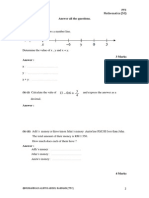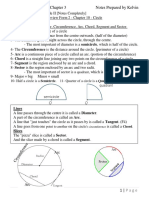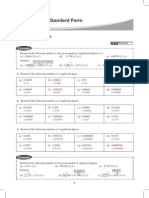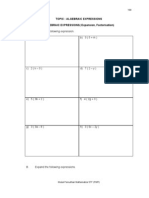100%(2)100% found this document useful (2 votes)
4K viewsMathematics Form 3 Chapter 2 Polygon Exercise
The document contains exercises on polygons including calculating angles, properties of regular polygons, symmetry of shapes, and types of quadrilaterals. There are multiple parts to each exercise and the document also includes the answers.
Uploaded by
G.k. Vinnan RaoCopyright
© © All Rights Reserved
Available Formats
Download as PDF, TXT or read online on Scribd
100%(2)100% found this document useful (2 votes)
4K viewsMathematics Form 3 Chapter 2 Polygon Exercise
The document contains exercises on polygons including calculating angles, properties of regular polygons, symmetry of shapes, and types of quadrilaterals. There are multiple parts to each exercise and the document also includes the answers.
Uploaded by
G.k. Vinnan RaoCopyright
© © All Rights Reserved
Available Formats
Download as PDF, TXT or read online on Scribd
You are on page 1/ 6
The Gatsby Charitable Foundation
MEP: Demonstration Project Teacher Support Y8B
UNIT 15 Polygons Extra Exercises 15.1
1. Calculate the size of the angle marked with a letter in each of the following diagrams:
(a) (b)
(c) (d)
2. Calculate the size of the unknown angle in each of the following triangles:
(a) (b) (c)
3. Calculate the size of each of the angles marked with a letter in the following diagrams:
(a) (b) (c)
(d) (e) (f)
70
a
170
70
b 40
60
c
55
120
46 71
20
65 a
b
121
d c
55
f
e
58
g
61
i h
60
42
k
j
48
m
l
41
n
o
42
d
89
31
25
The Gatsby Charitable Foundation
MEP: Demonstration Project Teacher Support Y8B
UNIT 15 Polygons Extra Exercises 15.2
1. Calculate the sizes of the exterior angles of a regular polygon which has interior
angles of:
(a) 160
(b) 156
(c) 144
2. Calculate the size of both the exterior and interior angles of a regular polygon with:
(a) 15 sides,
(b) 40 sides,
(c) 18 sides.
3. The exterior angle of a regular polygon is 15 . How many sides does this polygon have?
4. How many sides does a polygon have, if its exterior angle is 5 ?
The Gatsby Charitable Foundation
MEP: Demonstration Project Teacher Support Y8B
UNIT 15 Polygons Extra Exercises 15.3
1. Copy each of the following shapes and draw in all the lines of symmetry.
(a) (b)
(c) (d)
2. State the order of rotational symmetry of each of the following shapes:
(a) (b) (c)
3. Draw a shape which has:
(a) 1 line of symmetry, and rotational symmetry of order 1,
(b) 4 lines of symmetry, and rotational symmetry of order 4, but which is not a square.
The Gatsby Charitable Foundation
MEP: Demonstration Project Teacher Support Y8B
UNIT 15 Polygons Extra Exercises 15.4
1. Copy the diagram below and complete each of the shapes to form the type of
quadrilateral stated.
(a) (b) (c)
(d) (e) (f)
2. Is each of the following statements true or false ?
(a) A square is also a parallelogram.
(b) A square is also a kite.
(c) A kite is also a rhombus.
(d) A rhombus is also a kite.
(e) A rectangle is also a rhombus.
(f) A rectangle is also a parallelogram.
3. Which quadrilaterals have diagonals that are always equal in length?
4. Draw a trapezium that is neither a square nor a rectangle, but that has diagonals the
same length.
SQUARE
PARALLELOGRAM RHOMBUS
PARALLELOGRAM TRAPEZIUM
KITE
The Gatsby Charitable Foundation
MEP: Demonstration Project Teacher Support Y8B
Extra Exercises 15.1 Answers
1. (a) a = 120 (b) b = 70 (c) c = 125 (d) d = 49
2. (a) 63 (b) 70 (c) 124
3. (a) a b = = 65 50 , (b) c d = = 59 66 ,
(c) e f g = = = 122 122 58 , , (d) h i = = 59 121 ,
(e) j k = = 69 (f) l n o m = = = = 91 89 ,
Extra Exercises 15.2 Answers
1. (a) 20 (b) 24 (c) 36
2. (a) 24 156 , (b) 9 171 , (c) 20 160 ,
3. 24 sides
4. 72 sides
Extra Exercises 15.3 Answers
1. (a) (b)
(c) (d)
2. (a) 2 (b) 1 (c) 4
3. (a) For example see question 2 (b).
(b) For example see question 2 (c).
The Gatsby Charitable Foundation
MEP: Demonstration Project Teacher Support Y8B
Extra Exercises 15.4 Answers
1. (a) (b) (c)
(d) (e) (f)
2. (a) True (b) True (c) False
(d) True (e) False (f) True
3. Square, Rectangle
4.
e.g.
You might also like
- Analysing Political Speeches Rhetoric, Discourse and Metaphor (Jonathan Charteris-Black) (Z-Library)No ratings yetAnalysing Political Speeches Rhetoric, Discourse and Metaphor (Jonathan Charteris-Black) (Z-Library)314 pages
- Form 2 Mathematics Notes +exercise by Kelvin - Chapter 80% (1)Form 2 Mathematics Notes +exercise by Kelvin - Chapter 88 pages
- 1 Algebraic Expression (FORM 1) Example: Algebraic Expression Ii (FORM 2)No ratings yet1 Algebraic Expression (FORM 1) Example: Algebraic Expression Ii (FORM 2)13 pages
- Problem Sheet - 1: Figure 1. Conduction Band Figure 2. Valance Band0% (1)Problem Sheet - 1: Figure 1. Conduction Band Figure 2. Valance Band2 pages
- KSSM Mathematics Form 2 Chapter 4 PolygonsNo ratings yetKSSM Mathematics Form 2 Chapter 4 Polygons2 pages
- Mathematics-Form 3-Chapter 3 Circle II by KelvinNo ratings yetMathematics-Form 3-Chapter 3 Circle II by Kelvin7 pages
- Mathematics-Form 3-Chapter 2 Polygons II by Kelvin100% (3)Mathematics-Form 3-Chapter 2 Polygons II by Kelvin8 pages
- Form 2 Maths Year End Assessment (22-11 - 2020)No ratings yetForm 2 Maths Year End Assessment (22-11 - 2020)13 pages
- Han Chiang High School: Second Semester Mid-Term Test, 2020 Candidate Name School NumberNo ratings yetHan Chiang High School: Second Semester Mid-Term Test, 2020 Candidate Name School Number10 pages
- Formulae: Mathematics Form 2 Standardised Test 1: Circles Duration: 30 MinutesNo ratings yetFormulae: Mathematics Form 2 Standardised Test 1: Circles Duration: 30 Minutes4 pages
- Maths Form 3 Chapter 5 Trigonometri Ratios Exercise 10% (1)Maths Form 3 Chapter 5 Trigonometri Ratios Exercise 12 pages
- Algebraic Expressions III & Algebraic Formulae100% (1)Algebraic Expressions III & Algebraic Formulae5 pages
- Circular Measure Enrichment Paper 2 Trials 2011No ratings yetCircular Measure Enrichment Paper 2 Trials 20116 pages
- Review Exercise: (Form 2) Chapter 6-Pythagoras' Theorem80% (10)Review Exercise: (Form 2) Chapter 6-Pythagoras' Theorem5 pages
- KSSM Mathematics Form 2 Chapter 4 PolygonsNo ratings yetKSSM Mathematics Form 2 Chapter 4 Polygons7 pages
- Form 5 Mathematics Revision Set 3 (Transformation)No ratings yetForm 5 Mathematics Revision Set 3 (Transformation)3 pages
- MODULE 14 Algebraic Exp Expand Factor Is at IonNo ratings yetMODULE 14 Algebraic Exp Expand Factor Is at Ion6 pages
- UNIT 15 Polygons Revision Test 15.1: (Standard)No ratings yetUNIT 15 Polygons Revision Test 15.1: (Standard)9 pages
- Quiz 1 Polygon and Quadrilateral PacketNo ratings yetQuiz 1 Polygon and Quadrilateral Packet35 pages
- Rrtdo Aql3o: JR D 'A, Uau 33u 1sqns,!1e3No ratings yetRrtdo Aql3o: JR D 'A, Uau 33u 1sqns,!1e31 page
- Forouzan MCQ in Introduction To Data Communications and NetworkingNo ratings yetForouzan MCQ in Introduction To Data Communications and Networking13 pages
- MKTG3002 Digital and Social Media Marketing: Lectorial 1No ratings yetMKTG3002 Digital and Social Media Marketing: Lectorial 148 pages
- Communication Skills Among University StudentsNo ratings yetCommunication Skills Among University Students6 pages
- 24by09in00002376 - Sky Ventureszdup - 27-07-2024No ratings yet24by09in00002376 - Sky Ventureszdup - 27-07-20242 pages
- Solved If The Cubic Total Cost Function Described in The TextNo ratings yetSolved If The Cubic Total Cost Function Described in The Text1 page
- Polisomnografí A Dinamica No Dise.: Club de Revistas Julián David Cáceres O. OtorrinolaringologíaNo ratings yetPolisomnografí A Dinamica No Dise.: Club de Revistas Julián David Cáceres O. Otorrinolaringología25 pages
- Determination 446 Pesticides Residue by GC Ms and LC MsNo ratings yetDetermination 446 Pesticides Residue by GC Ms and LC Ms32 pages
- Climate Protection and Environmental Interests in Renewable Energy Law: Perspectives From Brazil and Germany Paula Galbiatti Silveira100% (2)Climate Protection and Environmental Interests in Renewable Energy Law: Perspectives From Brazil and Germany Paula Galbiatti Silveira49 pages
- Aiwa XR-MS5 Verticle CD Executive Micro System ManualNo ratings yetAiwa XR-MS5 Verticle CD Executive Micro System Manual18 pages
- Analysing Political Speeches Rhetoric, Discourse and Metaphor (Jonathan Charteris-Black) (Z-Library)Analysing Political Speeches Rhetoric, Discourse and Metaphor (Jonathan Charteris-Black) (Z-Library)
- Form 2 Mathematics Notes +exercise by Kelvin - Chapter 8Form 2 Mathematics Notes +exercise by Kelvin - Chapter 8
- 1 Algebraic Expression (FORM 1) Example: Algebraic Expression Ii (FORM 2)1 Algebraic Expression (FORM 1) Example: Algebraic Expression Ii (FORM 2)
- Problem Sheet - 1: Figure 1. Conduction Band Figure 2. Valance BandProblem Sheet - 1: Figure 1. Conduction Band Figure 2. Valance Band
- Mathematics-Form 3-Chapter 2 Polygons II by KelvinMathematics-Form 3-Chapter 2 Polygons II by Kelvin
- Han Chiang High School: Second Semester Mid-Term Test, 2020 Candidate Name School NumberHan Chiang High School: Second Semester Mid-Term Test, 2020 Candidate Name School Number
- Formulae: Mathematics Form 2 Standardised Test 1: Circles Duration: 30 MinutesFormulae: Mathematics Form 2 Standardised Test 1: Circles Duration: 30 Minutes
- Maths Form 3 Chapter 5 Trigonometri Ratios Exercise 1Maths Form 3 Chapter 5 Trigonometri Ratios Exercise 1
- Review Exercise: (Form 2) Chapter 6-Pythagoras' TheoremReview Exercise: (Form 2) Chapter 6-Pythagoras' Theorem
- Form 5 Mathematics Revision Set 3 (Transformation)Form 5 Mathematics Revision Set 3 (Transformation)
- Forouzan MCQ in Introduction To Data Communications and NetworkingForouzan MCQ in Introduction To Data Communications and Networking
- MKTG3002 Digital and Social Media Marketing: Lectorial 1MKTG3002 Digital and Social Media Marketing: Lectorial 1
- Solved If The Cubic Total Cost Function Described in The TextSolved If The Cubic Total Cost Function Described in The Text
- Polisomnografí A Dinamica No Dise.: Club de Revistas Julián David Cáceres O. OtorrinolaringologíaPolisomnografí A Dinamica No Dise.: Club de Revistas Julián David Cáceres O. Otorrinolaringología
- Determination 446 Pesticides Residue by GC Ms and LC MsDetermination 446 Pesticides Residue by GC Ms and LC Ms
- Climate Protection and Environmental Interests in Renewable Energy Law: Perspectives From Brazil and Germany Paula Galbiatti SilveiraClimate Protection and Environmental Interests in Renewable Energy Law: Perspectives From Brazil and Germany Paula Galbiatti Silveira
- Aiwa XR-MS5 Verticle CD Executive Micro System ManualAiwa XR-MS5 Verticle CD Executive Micro System Manual





























































































